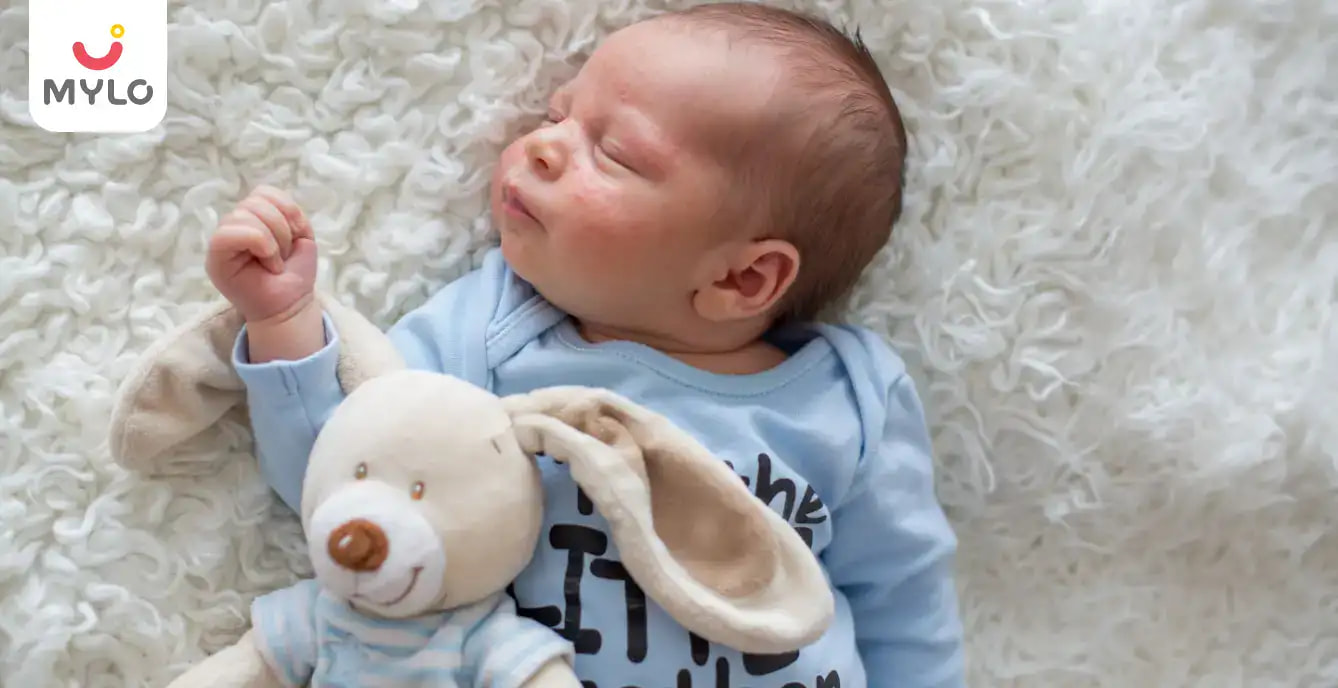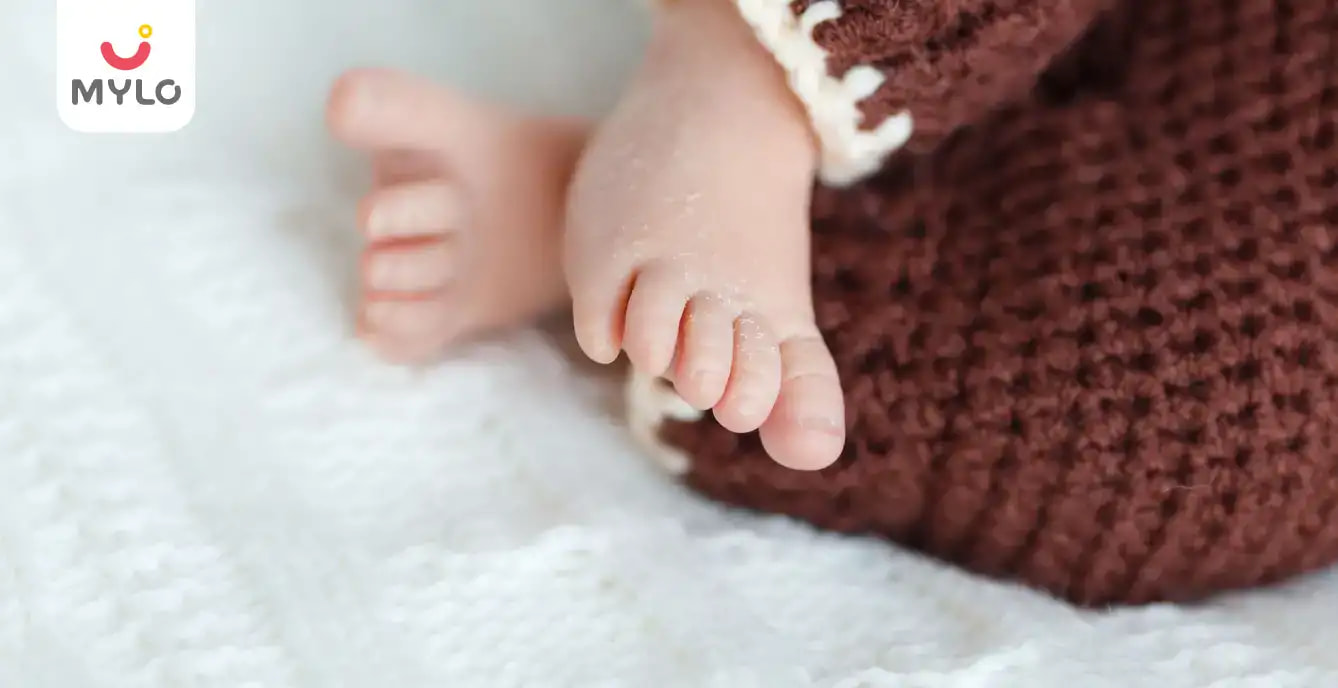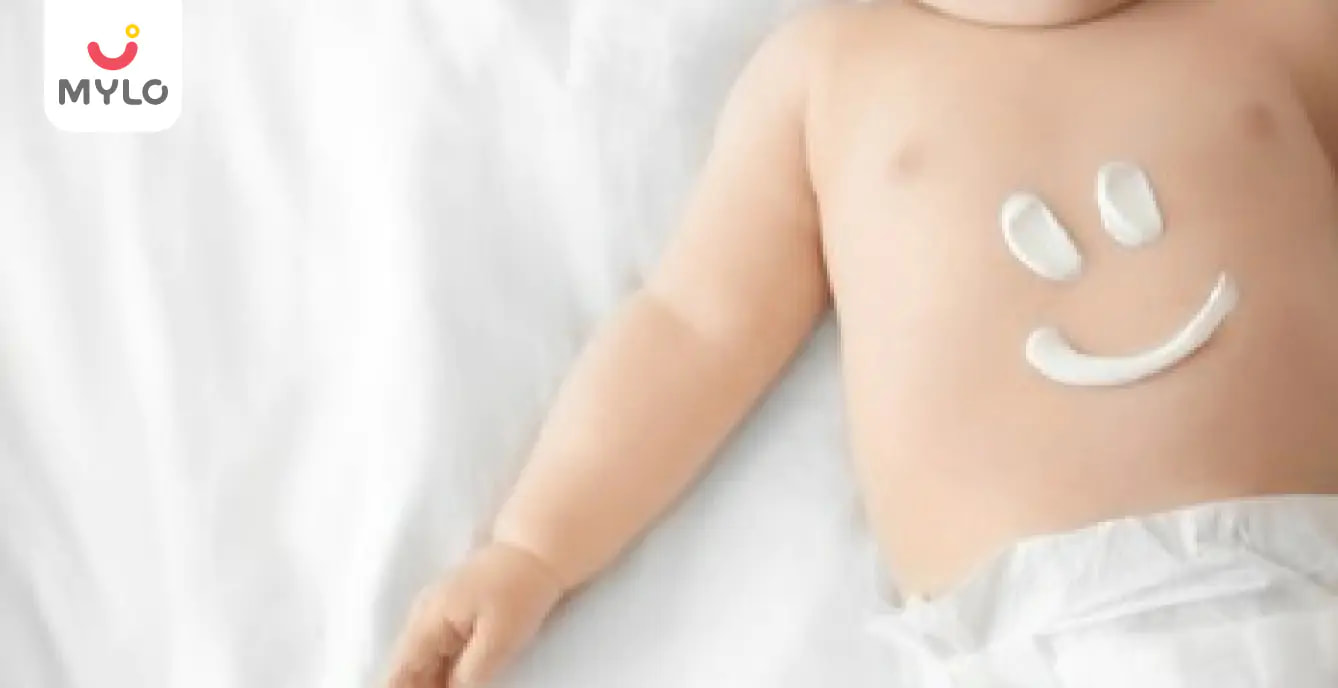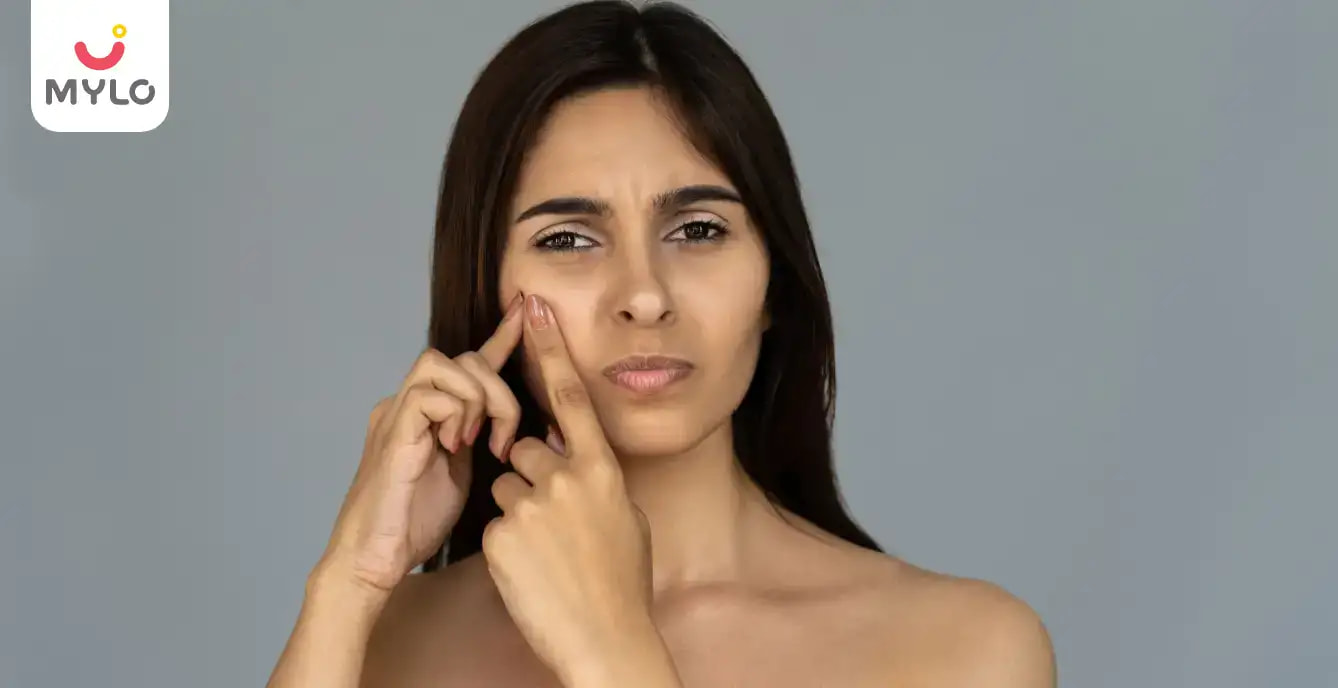Home

Care for Baby

Baby Acne: Causes & Symptoms
In this Article

Care for Baby
Baby Acne: Causes & Symptoms
Updated on 3 November 2023
Baby acne in newborns is a skin ailment characterized by the appearance of small, red, or white bumps or pimples on the skin. Although most cases of this occur during the first and fourth weeks of a baby's life, it can occur at birth. Even while baby acne is extremely common in infants, it can be distressing to watch those little spots develop worse.
Erythema toxicum neonatorum (ETN) is the medical word for infant acne, but don't let the name fool you. Approximately 4.5 out of 10* infants are diagnosed with this condition, making it a highly common disease.
Neonatal acne is also known as cephalic pustulosis or newborn acne. Small pimples and pustules appear on the baby's face and head somewhere between the ages of two and four weeks.
Acne in babies is distinct from infantile acne, which typically appears between three and six months of age, and adult acne. Do check in with your family doctor if you have any doubts.
What is Baby Acne
Baby acne is a common skin condition that usually only lasts for a short time. It can happen on a baby's face or body. It makes small bumps or pimples that are red or white. Acne almost always goes away on its own without any treatment.
Baby acne is also called neonatal acne. It happens to about 20% of babies when they are born.
Baby acne is different from infantile acne because it doesn't usually have open comedones or blackheads. When a child has acne, these symptoms are common. Acne in babies can also show up as cysts or nodules. Without treatment, it can sometimes leave scars.
Acne in babies only happens in the first few months of their lives. Acne in babies can last until they are 2 years old. Baby acne is much more common than acne in babies.
Symptoms of Infant Acne
Baby acne usually looks like red bumps or pimples, just like acne in teens and adults. There may also be white pustules or whiteheads, and the skin around the bumps may be red.
Acne can happen anywhere on a baby's face, but it usually starts on the cheeks. Some babies may also have acne on their upper backs or necks.
If the baby is fussy or cries a lot, acne may get worse. Acne can get worse if the baby wears rough clothes or if vomit or saliva stays on the baby’s face.
There are times when babies are born with acne. But it usually shows up between two and four weeks after birth. And it could last a few days or weeks, but in some cases, it could last for months.
Causes of Newborn Acne
Acne in infants has several possible reasons, but experts can only speculate:
-
Rashes of yeast infection on infants' skin
-
Pregnancy-related hormonal changes in the placenta might cause an overproduction of oil in the baby's epidermis
Some researchers think the condition is caused by genes, hormones in the mother and baby, or things in the environment that irritate the skin. Baby acne is common, but it usually goes away quickly.
Teenagers and adults often get hormonal acne, and hormones from the mother are still in a baby's body for the first few weeks of life. It is thought that leftover hormones can cause a type of acne in babies called hormonal acne. During pregnancy, hormones in the placenta can also make the oil glands on a baby's skin work too hard. This could then lead to acne later on.
Because a baby's pores don't fully form until after birth, they may be more likely to get acne from irritants in the outside world. The acne a baby gets has nothing to do with the acne a teen might get.
When to Consult a Doctor
Although infant acne is very common, it can be upsetting to see the pimples spread. There is currently no treatment for infant acne, parents who are concerned should discuss their child's case with a pediatrician. The best time to discuss baby acne and other health concerns is during a well-baby or general visit.
Blackheads, pustules, and inflammation are all signs that the baby's acne needs medical attention. If the infant is experiencing any discomfort or seems ill, they should also visit a doctor.
A lotion containing 2.5 percent benzoyl peroxide may be recommended by the doctor if the baby's acne does not clear up after a few months of at-home treatment.
Rarely, antibiotics like erythromycin or isotretinoin may be prescribed to ensure that the scars fade away quickly. This is typically only necessary for infants who have medically-induced acne.
However, if the child experiences acne again before they reach puberty, it may be indicative of a more serious issue and they should visit a doctor.



Written by
Priyanka Verma
Priyanka is an experienced editor & content writer with great attention to detail. Mother to an 11-year-old, she's a ski
Read MoreGet baby's diet chart, and growth tips

Related Articles
Related Questions
Hello frnds..still no pain...doctor said head fix nhi hua hai..bt vagina me pain hai aur back pain bhi... anyone having same issues??

Kon kon c chije aisi hai jo pregnancy mei gas acidity jalan karti hain... Koi btayega plz bcz mujhe aksar khane ke baad hi samagh aata hai ki is chij se gas acidity jalan ho gyi hai. Please share your knowledge

I am 13 week pregnancy. Anyone having Storione-xt tablet. It better to have morning or night ???

Hlo to be moms....i hv a query...in my 9.5 wk i feel body joint pain like in ankle, knee, wrist, shoulder, toes....pain intensity is high...i cnt sleep....what should i do pls help....cn i cosult my doc.

Influenza and boostrix injection kisiko laga hai kya 8 month pregnancy me and q lagta hai ye plz reply me

Related Topics
RECENTLY PUBLISHED ARTICLES
our most recent articles

Diet & Nutrition
গর্ভাবস্থায় আলুবোখরা: উপকারিতা ও ঝুঁকি | Prunes During Pregnancy: Benefits & Risks in Bengali

Diet & Nutrition
গর্ভাবস্থায় হিং | ঝুঁকি, সুবিধা এবং অন্যান্য চিকিৎসা | Hing During Pregnancy | Risks, Benefits & Other Treatments in Bengali

Women Specific Issues
স্তনের উপর সাদা দাগ: লক্ষণ, কারণ এবং চিকিৎসা | White Spots on Nipple: Causes, Symptoms, and Treatments in Bengali

Diet & Nutrition
গর্ভাবস্থায় পোহা: উপকারিতা, ধরণ এবং রেসিপি | Poha During Pregnancy: Benefits, Types & Recipes in Bengali

Diet & Nutrition
গর্ভাবস্থায় মাছ: উপকারিতা এবং ঝুঁকি | Fish In Pregnancy: Benefits and Risks in Bengali

Diet & Nutrition
গর্ভাবস্থায় রেড ওয়াইন: পার্শ্ব প্রতিক্রিয়া এবং নির্দেশিকা | Red Wine During Pregnancy: Side Effects & Guidelines in Bengali
- ইনার থাই চ্যাফিং: কারণ, উপসর্গ এবং চিকিৎসা | Inner Thigh Chafing: Causes, Symptoms & Treatment in Bengali
- গর্ভাবস্থায় ব্রাউন রাইস: উপকারিতা ও সতর্কতা | Brown Rice During Pregnancy: Benefits & Precautions in Bengali
- Velamentous Cord Insertion - Precautions, Results & Safety
- Unlock the Secret to Flawless Skin: 7 Must-Have Qualities in a Face Serum
- Unlock the Secret to Radiant Skin: How Vitamin C Serum Can Transform Your Complexion
- Gender No Bar: 10 Reasons Why Everyone Needs a Body Lotion
- Unlock the Secret to Radiant Skin How to Choose the Perfect Body Lotion for Your Skin Type
- Top 10 Reasons to Apply a Body Lotion After Every Bath
- Communication in Toddlers: Milestones & Activities
- How to Improve Vocabulary for Toddlers?
- A Comprehensive Guide to Understanding Placenta Accreta
- Vulvovaginitis in Toddlers Causes, Symptoms and Treatment
- A Comprehensive Guide to Understanding Cerebral Palsy in Children
- Bitter Taste in Mouth During Pregnancy: Understanding the Causes and Remedies


AWARDS AND RECOGNITION

Mylo wins Forbes D2C Disruptor award

Mylo wins The Economic Times Promising Brands 2022
AS SEEN IN
















- Mylo Care: Effective and science-backed personal care and wellness solutions for a joyful you.
- Mylo Baby: Science-backed, gentle and effective personal care & hygiene range for your little one.
- Mylo Community: Trusted and empathetic community of 10mn+ parents and experts.
Product Categories
baby carrier | baby soap | baby wipes | stretch marks cream | baby cream | baby shampoo | baby massage oil | baby hair oil | stretch marks oil | baby body wash | baby powder | baby lotion | diaper rash cream | newborn diapers | teether | baby kajal | baby diapers | cloth diapers |








